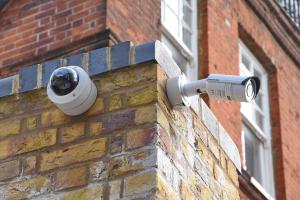AI-Powered Surveillance: the Future of CCTV?
While CCTV surveillance cameras have become a staple for passive home surveillance and security technology in general, the advent of artificial intelligence (AI) has created more dynamic, efficient, and proactive alternatives: AI-powered surveillance systems.
The benefits of the mix of AI and classic CCTV systems are extremely valuable and extensive. In short, a surveillance device that is powered by AI can rapidly identify a plethora of anomalies along with their associated threats to the security of homes and business spaces. At the same time, they can immediately dispatch emergency response teams to the address while helping law enforcement with solving crimes quicker and more efficiently.
Our pros have compiled a brief guide that should introduce you to the brand-new era of security that we are witnessing unfold in front of our eyes in real time. Keep reading to learn how you could benefit from the symbiotic relationship between CCTV, machine learning, and AI.
Learn what are the main pros and cons of this innovative technology that promises to increase protection and optimize retail, law enforcement, and smart city life.
AI and CCTV - Overview
The role of AI in the development of CCTV systems is critical in several fields and applications:
Real-Time Object Recognition
The mix enables real-time object recognition. This means home and business owners can install AI-powered surveillance cameras that can effectively distinguish passing cars, pets, humans, vehicles, and certain objects.
Facial Recognition Solutions
The integration of facial recognition technologies is another breakthrough in the security industry. With it, you can now significantly improve your identification and tracking abilities. This also includes customer behavior tracking, store layout optimization for businesses, and better marketing strategies, on top of the valuable shoplifting prevention role.
For smart cities that are being built as we speak, modern-day AI-driven CCTV systems allow better environmental and traffic-related monitoring and management, bringing their contribution to urban sustainability.
Since AI-powered devices use algorithms generated by the real world, they are capable of gaining a deep understanding of complex types of human behaviors and environments. Accordingly, smart cities can rely on these adaptive systems to keep up with the ever-changing environment while constantly increasing their performance in time.
Video Footage Analysis
Besides their standard role of deterring potential burglars and recording footage 24/7 or whenever motion is detected to prevent the upload of large files to the Cloud, CCTV cameras that rely on AI can be used for a plethora of other purposes:
Identifying Anomalies
AI-based surveillance cameras can be used to identify anomalies, threats, and hazards while assisting the authorities with the capturing of thieves or intruders. This is due to AI-driven video analytics in which these devices can complete the time-consuming, laborious task in a swift, hassle-free manner.
Tracking Behavioral Patterns
Using advanced algorithms, AI extracts previous patterns and insights that would normally go unnoticed by the human eye. This makes the identification of a plethora of patterns and behaviors possible, followed by well-targeted responses.
Retail businesses, manufacturing companies, and the healthcare sector in general can benefit from these AI-based solutions when embedded in their surveillance systems. For example, AI can support patient diagnosis and monitoring practices by recognizing any small or subtle changes in patients’ vital signs. Manufacturers can improve their quality control and optimize their processes while considerably cutting potential risks.
Crime Prevention Via Predictive Policing
The term “predictive policing” refers to a series of law enforcement strategies that rely on demographics, historical crime data, and other data sources to predict and stop crimes before they happen. For example, AI-driven predictive policing can improve public safety by accurately identifying those areas with high risks of crime and guaranteeing faster response times.
They can also cut the number of crimes using an advanced, proactive approach, preventing offenses before they occur.
Another critical problem that AI-driven security systems can solve is the better allocation of resources through optimization. This allows law enforcement agencies to make use of their resources and staff more efficiently, potentially leading to cost savings.
Traffic Management in Smart Cities
Smart cities that incorporate a variety of AI applications manage to simplify residents’ lives in many ways. One of them is improving transportation systems with the help of AI-based CCTV systems that help with real-time traffic monitoring. Advanced algorithms are used to supervise the flow of traffic, identify accidents, cut down polluting emissions, decrease the rate of congestion, and offer overall improved experiences for drivers.
Energy Savings in Smart Cities
AI CCTV systems can also help cut the consumption of energy by using real-time human activity and weather conditions to optimize street lighting. The management of wastage and water leaks can also be optimized with the help of similar insights that use artificial intelligence, helping city managers preserve resources and lower costs.
Cons of AI CCTV Systems
Some of the most important cons of AI CCTV systems regard matters of privacy and ethics. Namely, while AI-driven CCTV systems are growing in popularity, privacy concerns come into the picture. Smart cities must be designed in such a way that they strike a delicate balance between guaranteeing the security of individuals while also accurately preserving their freedoms, rights, and liberties.
In some cases, fast movements can generate issues for machine vision systems, which can prove to be detrimental in several applications where safety is crucial. Machine vision systems may not always correctly recognize the same object with slight deviations. When the purpose is the identification of pedestrians with articulating limbs for operational safety, quality training sets need to be provided for the AI to learn from. However, this can be challenging to do.
All in all, in the fast-evolving evolving realm of monitoring systems, the implementation of AI has initiated a brand new era of innovation with boundless potential on the horizon. Ethical considerations and several implementation problems, however, need to be tackled for a safer and more responsible path forward.

 Locksmith Service
Locksmith Service






